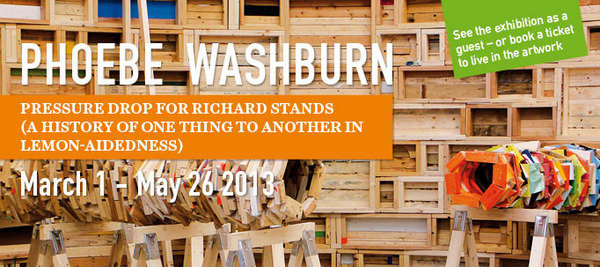Phoebe Washburn
dal 27/2/2013 al 25/5/2013
Segnalato da
27/2/2013
Phoebe Washburn
Brandts Mediemuseet, Fotokunst, Kunsthallen, Odense
Pressure Drop for Richard Stands (a history of one thing to another in lemonaideness). Washburn will build two different installations linked by a water cleansing system that connects to a hospital-like nursery for plants.

In the two large, adjoining exhibition rooms at Kunsthallen, covering 800 square meters, Phoebe Washburn will build two different installations linked by a water cleansing system that connects to a hospital-like nursery for plants.
Inside a large-scale, wooden construction in one of the rooms, at the height of four meters, a small apartment will be installed. Every day between 10 am and 5 pm it will be occupied by two people who will prepare lunch for themselves and spend the time working on the net, knitting, or playing the guitar – depending on their interests. In between they will serve the public energy drinks and offer information. The water from the dishwasher and other housekeeping usage is cleansed on its way to the second room via “lungs” and a “heart” and afterwards distributed via a great many channels to rows of hand-woven “hospital beds”. Here plants are grown from new shoots which are replanted when their roots have formed and transferred to beds on the floor below the first room, or more precisely: in the building’s wormholes. The cleansed water is also led through other channels to an external terrace where various kinds of plants are meant to grow, and inside the new shoots are cultivated under varying degrees of light and care. The custodians at Kunsthallen will tend the plants.
Phoebe Washburn’s intention is to create artworks which are partly self-productive. We are dealing with circulation processes and strategies for sustainability transformed into artworks. Encounters between contradictory elements of growth and decay, recycling and detritus, are combined with surprising, monumental sculptural forms. From an art-theoretical point of view, Washburn’s form of expression can be seen as a further development of arte povera (detritus and recycling), process art (circulation, growth, change) and the systemic aesthetics of post-minimalism (technology, sociology, ecology).
In the US, Phoebe Washburn has enjoyed a meteoric career from the Whitney and the Guggenheim to several other major American museums. Her exhibition at Kunsthallen Brandts, opening on the first of March, 2013, will be her third show in Europe, and her first ever in Scandinavia. At Kunsthallen Brandts we see her exhibition as a significant further step in our presentations of installation art, among which the work created in 2005 by Jessica Stockholder represented a great international artist’s original bid on painting/sculpture in the expanded field. We consider it an important part of the exhibition policy at Kunsthallen Brandts to follow up on new forms of expression in art and introduce the Danish public to interesting, lesser-known artists. This exhibition is site-specific and will not travel to other exhibition venues.
About the Artist
Phoebe Washburn (born 1973 in New York) works with recycled products to create large-scale works that make up self-contained, biotope-like systems. She creates overwhelming and oversized constructions where intricately calculated processes connect machines and objects: well functioning – but also illogical – systems composed with scientific know-how and humour, lending her works the character of something monstrous and self-sufficient having a life of their own. This will be the third time Phoebe Washburn exhibits in Europe. In 2007 she created a large laboratory at Kestnergesellschaft, Hannover, and in 2009, at Deutsche Guggenheim, Berlin, she constructed a factory-like unit with organic production.
The exhibition will be accompanied by a catalogue featuring texts by an American and a Danish writer. It will also include photographs of the entire installation process up until the month of April when the catalogue goes into print.
For further information, please contact PR-manager
Trine Søndergaard, Phone: 0045 6520 7092. E-mail: trine.soendergaard@brandts.dk
Opening 28 February at 5pm.
Visual artist and professor Lone Hoyer Hansen will give the opening speech
Kunsthallen Brandts
Brandts Torv 1 5000 Odense, Denmark
Hours
Monday: closed
Thursday 12pm - 9pm
Tuesday through Sunday 10am-5pm
Admissions:
Individual ticket, adults
Ticket valid for all of Brandts: DKK 80
Kunsthallen Brandts (Art): DKK 50
Museet for Fotokunst (Photography): DKK 40 Mediemuseet (Media): DKK 40
Children (0 – 18) Ticket valid for all of Brandts: Admission free



